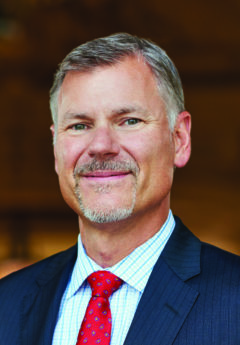HOME | ABOUT US | MEDIA KIT | CONTACT US | INQUIRE
HOME | ABOUT US | MEDIA KIT | CONTACT US | INQUIRE
Ray Kowalik is chairman and CEO of Burns & McDonnell, the largest engineering firm by revenues in the Kansas City region, and second-largest by employee totals.
Q. Your firm-wide revenue growth has been up sharply for most of the past decade, and your 2019 numbers led all other engineering firms in a market known as a center of design excellence. What factors have been behind that growth?
A. We ask that question of ourselves a lot, and you try to look at all the things that will help you be successful, understanding which of those are key and which are ones you don’t know if you can get done. For us, it’s extreme focus on client service, driven from an employee-ownership culture. Put those two together, find highly motivated people who work on behalf of costumers, then just give them the right tools and resources and let them go and be successful.
 Q. There’s more to it than just culture, though, isn’t there?
Q. There’s more to it than just culture, though, isn’t there?
A. Oh, sure. We have diversified locations, diversified services and offerings, and we’ve had a pretty good market the last couple of years, as did almost everybody in engineering and construction. But we’ve also been pretty innovative in getting into new business lines and services.
Q. Which of those have been most fruitful?
A. We bought a couple of construction companies in the past three years, and we’ve been able to sell our EPC (engineering procurement construction) design/build in package deals with really good teams, getting to good quality, good price, hitting budget and schedule. Then, in the past few years, we’ve been heavily into the data-center business, hired extremely good talent, and that business line is still exploding. Then there’s real estate development, and that’s going really well. And our 1898 & Co. line is getting more into high-end consulting services for customers.
Q. You can’t talk business these days without touching on the COVID-19 pandemic. Do you see that slowing down the growth trends?
A. It’s really too early to tell. What we have to figure out is when will we get back to “normal” and what that’s going to look like, how consumer habits may change, how spending changes with those. While it’s kind of early to tell what the long-term impact is, the short-term is pretty severe in the oil/gas business. Oil is next to nothing in price, and that has created lot of financial strain on the oil and gas industry. Many projects—shutting down, delaying, postponing, whatever word you use—are being held up. We’re trying to reallocate resources to lines that are busy, like data centers, communications, food and consumer products. The stat I think I heard was that with the food supply, grocers vs. restaurants, the restaurants were at 10 percent of previous demand, but groceries has doubled. So the supply chain is out of whack. The question now is how it gets back in balance, and how will it look six months, a year from now, two years from now. But we’re definitely seeing the big impact in oil and gas.
Q. To the extent you are involved with design and construction of high-density gathering spaces, what are you hearing about how people might interact after this health crisis, and whether it will affect design of the built environment?
A. We do office buildings, including our own, but it boils down to the same comment about how consumer habits will change. I’m not a big believer that this is going to create an environment where a small percentage of people work in offices and 90 percent work at home. I think that’s unsustainable, when you think about things like quality, and the mentorship, tutoring and training that won’t happen in that dynamic. Maybe in some industries.
Q. Do existing communications infrastructure and user technology advances support more of that remote-work demand?
A. Quite honestly, the new technologies are robust enough to allow collaboration for remote locations, but you’ve got to have good broadband. We made a shift a couple of years ago to put all of our data in the cloud, with off-site data centers where it is more easily accessible to all employees. That has allowed more of us to work from home over the past two to five years, and we’ve shown we can make it work. However, the leadership, senior management, department and section leaders are feeling the stress of managing in that environment. Doing those kinds of interactions with groups is very difficult in a remote environment. Will that change what the office looks like? It will allow more work from home, and it will lead to better collaboration tools. But I don’t think we’re looking at a fundamental shift where 90 percent of the people work from home.